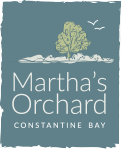Butterflies
Did you know that the average butterfly has an adult life span of two weeks or less? Below are just a few of the species that can be found either in the sensory garden at Martha’s Orchard or nearby.
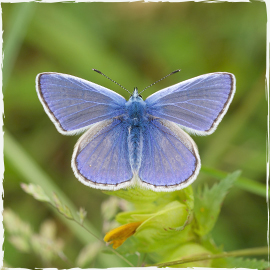
Common Blue
Look out for a tiny flash of bright blue when you are out walking. It will be the upper wing colour of the male Common Blue Butterfly, the females are duller in appearance and are almost completely brown. One of the smallest of the UK butterflies, their wing span is only 35 mm. They often have two broods (emerging twice a year in May and then again in late July).
When to see: May to September
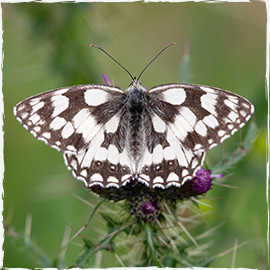
Marbled White
When you see a Marbled White you know that summer has definitely arrived. Its favourite food plant is Field Scabious, Common Knapweed and Wild Marjoram which can be found in the roadside verges and wildfower meadows close by. If you spot one there will be more as they emerge in large colonies. The Marbled White is a medium sized butterfly with a wingspan of 53-58 mm and they only have one brood per year.
When to see: June to August
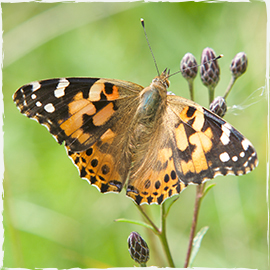
Painted Lady
The Painted Lady is a migrating butterfly and spends the winter in Northern Africa. They arrive back to the UK in late May to early June. One of their favourite food plants is the Buddleia Tree otherwise know as the Butterfly Bush as its very rich in nectar. When you are walking in the lane near Martha’s Orchard take a look at the purple Buddleia Trees and see if you can spot a Painted Lady. The Painted Lady is a medium sized butterfly with a wingspan of 50-56 mm and they only have one brood per year.
When to see: May to October
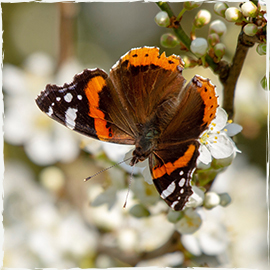
Red Admiral
One of the largest of the UK’s butterflies, the Red Admiral can be identified by its strong orange-red band on each upper wing. Red Admirals also like to drink nectar from a favourite plant – the Buddleia. In the summer months, keep a look out for lots of tiny black caterpillars on common nettles as the Red Admiral lays its eggs in the nettle tips. The Red Admiral is a large sized butterfly with a wingspan of 64-78 mm and they only have one brood per year. (Red Admiral Hibernate through the cold winter months)
When to see: All Year Around
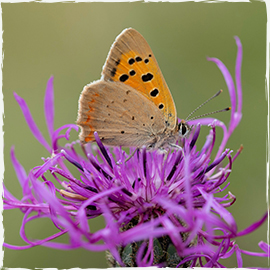
Small Copper
The Small Copper is a small bright orange butterfly that can be found in colonies nearby. The males are very territorial and will chase off any insect passing to close and then return to its favourite spot to sunbathe. One of their favourite food plants is yellow ragwort which can be found in the wildflower meadows on the Trevose headland. The Small Copper is a tiny sized butterfly with a wingspan of 32-35 mm and they can have up to three broods per year. (emerging twice a year in May and then again in late July)
When to see: April/May to October
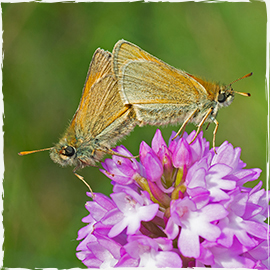
Small Skipper
The Small Skipper emerges in late June. The tiny orange butterfly could almost be called a moth in the way that it flies. Look out for them posing in the sunshine on the end of long grass stems, wings held in the half-open posture distinctive of skipper butterflies. The Small Skipper feeds on Knapweed, has a wingspan of just 30 mm and only has one brood per year.
When to see: Mid June to mid August
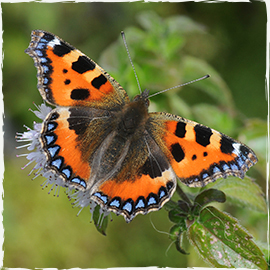
Small Tortoiseshell
One of the first butterflies to be seen in spring. They can be found in and around Martha’s Orchard especially in the sensory garden. Slightly smaller in size than the Red Admiral, the orange and black patterning on the upper wings makes for a very recognisable butterfly. The Small Tortoiseshell is a medium/large sized butterfly with a wingspan of 50-56 mm and they can have up to two broods per year. (Small Tortoiseshell Hibernate through the cold winter months)
When to see: All Year Around
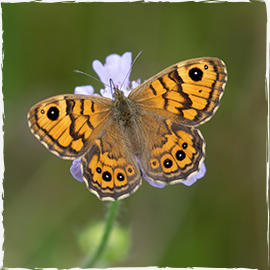
Wall Brown
The Wall Brown can be seen basking on stone walls, rocks, and stony places. One of the best places to spot one is along the coastal path around Mother Ivey’s Bay and the Trevose Headland. Butterflies need warmth and and the sun to be able to fly and the Wall Brown manages to do this by basking in sheltered sunny places. The Wall Brown is a medium sized butterfly with a wingspan of 45-53 mm and they can have up to two broods per year (emerging twice a year in May and then again in late July).
When to see: May to October
All photographs © Adrian Langdon and Helen Llewelyn

